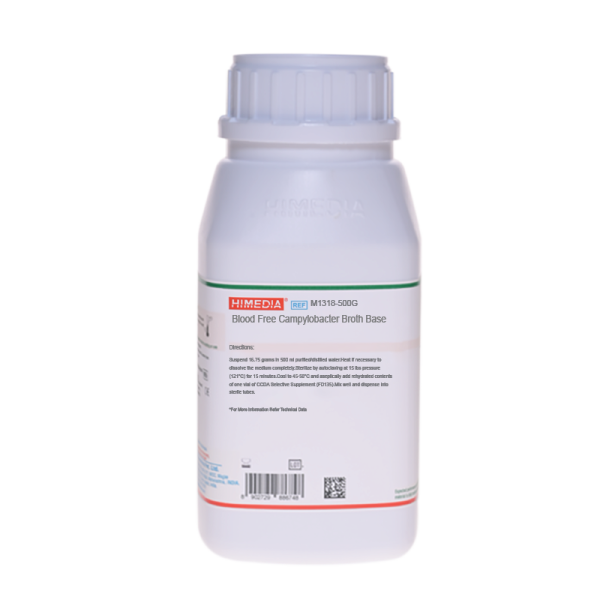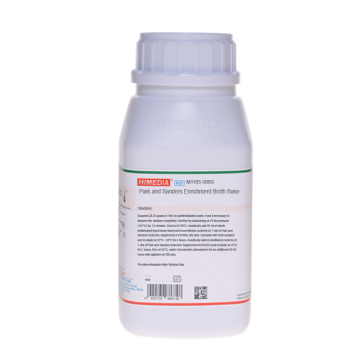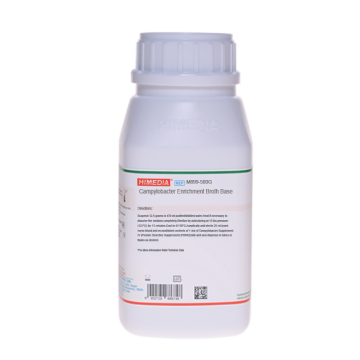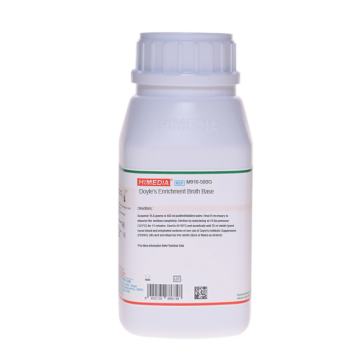 Your enquiry has been submitted
Your enquiry has been submitted
Blood Free Campylobacter Broth Base
Intended Use
Recommended for the selective isolation and differentiation of Campylobacter species.
Composition
| Ingredients | g/L |
|---|---|
| Peptone | 10.000 |
| HM Peptone B# | 10.000 |
| Tryptone | 3.000 |
| Sodium chloride | 5.000 |
| Sodium deoxycholate | 1.000 |
| Ferrous sulphate | 0.250 |
| Sodium pyruvate | 0.250 |
| Charcoal, bacteriological | 4.000 |
Final pH (at 25°C): 7.4±0.2
**Formula adjusted, standardized to suit performance parameters
# Equivalent to Beef extract
Directions
Suspend 16.75 grams in 500 ml purified/distilled water. Heat if necessary to dissolve the medium completely. Sterilize by autoclaving at 15 lbs pressure (121°C) for 15 minutes. Cool to 45-50°C and aseptically add rehydrated contents of 1 vial of CCDA Selective Supplement (FD135). Mix well and dispense into sterile tubes.
Principle And Interpretation
Campylobacter's are carried in the intestinal tract of animal and therefore contaminate foods of animal origin (1). Campylobacter causes intestinal upset or abortion in animals. It is also one of the most important causes of human gastroenteritis, particularly in children. Initially blood was used in the isolation of Campylobacter. But, later it was reported by Bolton et al (2) that charcoal could be effectively used in place of blood. This rules out the variability obtained due to the use of blood.
Blood Free Campylobacter Broth Base is used for selective isolation of Campylobacter species. Campylobacter species are highly resistant to cefoperazone, an antibiotic which effectively suppresses growth of Pseudomonas and Enterobacteriaceae (3,4,5). Addition of cefoperazone increases the selectivity of the medium. Due to this addition, the medium is also known as Campylobacter Charcoal Differential Agar (CCDA). Charcoal, sodium pyruvate and ferrous sulphate reduces the aero tolerance of medium by quenching photo chemically generated toxic oxygen derivatives (5). Peptone, tryptone and HM peptone B serve as sources of essential nutrients and amino acids. Casein is added to help grow certain strains of nalidixic acid resistant thermophilic Campylobacter from environmental samples (6). Amphotericin B suppresses the growth of yeast and mold contaminants.
Type of Specimen
Clinical material: stool; Food samples.
Specimen Collection and Handling
For clinical samples follow appropriate techniques for handling specimens as per established guidelines (7,8).
For food samples follow appropriate techniques for handling specimens as per established guidelines (1).
After use, contaminated materials must be sterilized by autoclaving before discarding.
Warning and Precautions
In Vitro diagnostic use. For professional use only. Read the label before opening the container. Wear protective gloves/protective clothing/eye protection/face protection. Follow good microbiological lab practices while handling specimens and culture. Standard precautions as per established guidelines should be followed while handling clinical specimens. Safety guidelines may be referred in individual safety data sheets.
Limitations
- Some species of Campylobacter may show poor growth due to nutritional variations.
- Further biochemical identification is required for complete identification.
Performance and Evaluation
Performance of the medium is expected when used as per the direction on the label within the expiry period when stored at recommended temperature.
Quality Control
Appearance: Grey to black homogeneous free flowing powder
Colour and Clarity of prepared medium: Black coloured opaque solution in tubes
Reaction: Reaction of 3.35% w/v aqueous solution at 25°C. pH: 7.4±0.2
pH: 7.20-7.60
Cultural Response
Cultural characteristics observed with added 1 vial of CCDA Selective Supplement(FD135) after an incubation at 30°C for 72 hours.
| Organism | Inoculum (CFU) | Growth |
|---|---|---|
| Campylobacter coli ATCC 33559 | 50-100 | good-luxuriant |
| Campylobacter jejuni ATCC 29428 (00156*) | 50-100 | good-luxuriant |
| Campylobacter laridis ATCC 35222 | 50-100 | good-luxuriant |
| Escherichia coli ATCC 25922 (00013*) | >=104 | inhibited |
Key: (*) - Corresponding WDCM numbers
Storage and Shelf Life
Store between 10-30°C in a tightly closed container and the prepared medium at 2-8°C. Use before expiry date on the label. On opening, product should be properly stored dry, after tightly capping the bottle in order to prevent lump formation due to the hygroscopic nature of the product. Improper storage of the product may lead to lump formation. Store in dry ventilated area protected from extremes of temperature and sources of ignition Seal the container tightly after use. Product performance is best if used within stated expiry period.
Disposal
User must ensure safe disposal by autoclaving and/or incineration of used or unusable preparations of this product. Follow established laboratory procedures in disposing of infectious materials and material that comes into contact with clinical sample must be decontaminated and disposed of in accordance with current laboratory techniques (7,8).
Reference
- Salfinger Y., and Tortorello M.L., 2015, Compendium of Methods for the Microbiological Examination of Foods, 5th Ed., American Public Health Association, Washington, D.C.
- Bolton F. J., Hutchinson D. N and Coates D., 1984, J. Clin. Microbiol., 19:169.
- Ahonkai V. I., et al, 1981, Antimicrob. Agents. Chemother.,20:850.
- Jones R. N., et al, 1980, Antimicrob. Agents. Chemother., 17:743
- Karmali M. A., et al, 1986, J. Clin. Microbiol., 23:456
- Koneman E. W., Allen S. D., Janda W. M., Schreckenberger P. C., Winn W. C. Jr., 1992, Colour Atlas and Textbook of Diagnostic Microbiology, 4th Ed., J. B. Lippinccott Company.
- Isenberg, H.D. Clinical Microbiology Procedures Handbook 2nd Edition.
- Jorgensen, J.H., Pfaller, M.A., Carroll, K.C., Funke, G., Landry, M.L., Richter, S.S and Warnock., D.W. (2015) Manual of Clinical Microbiology, 11th Edition. Vol. 1.
| Product Name | Blood Free Campylobacter Broth Base |
|---|---|
| SKU | M1318 |
| Product Type | Regular |
| Physical Form | Powder |
| Origin | Animal |
| Packaging type | HDPE |
| References | 1. Ahonkai V. I., et al, 1981, Antimicrob. Agents. Chemother.,20:850. |
| Customized Product Available | No |












